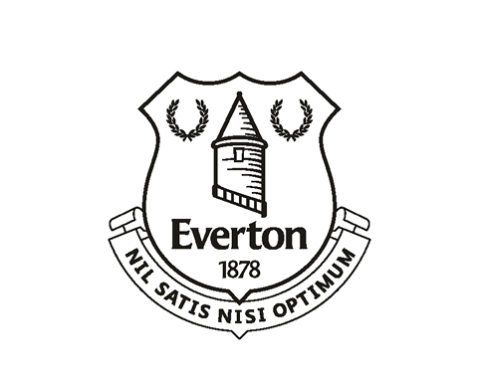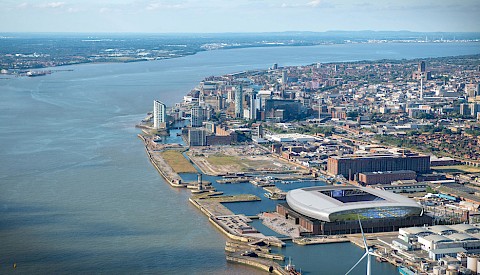Worthy successor to the "Grand Old Lady"
At a club whose motto is "Nil satis nisi optimum" ("Nothing but the best is good enough"), there is a taste for the out-of-the-ordinary. This is also the case with the long-awaited construction of a new home for the club and fans of Everton Football Club. It was therefore a special honor for Mannesmann Line Pipe to be involved in the construction of the new stadium.
Not only was Everton FC founded in 1878, but it also plays in one of the world’s oldest football stadiums. Goodison Park was built in 1892, and its name "The Grand Old Lady" is always uttered with reverence and respect. Like perhaps no other stadium, the Grand Old Lady stands for the tradition and history of English football. It was the first stadium to have a stand divided into three tiers and the first English football stadium to have a heated pitch. Its record attendance is 78,299 for the First Division fixture against Liverpool FC on 18 September 1948. With the onset of the 1990s seating era, spectator capacity was reduced to what is now just under 39,500.
The venue is located in a densely built-up residential area of Liverpool, which makes an extension or expansion to modern international standards impossible. For this reason, ideas for building a new stadium elsewhere had been floated since the 1990s.

"Nil satis nisi optimum – Nothing but the best is good enough"

The detailed visualisations of the new stadium building illustrate the building typology, roof and grandstand construction as well as the location on the Bramley-Moore Dock.
Rendering: © Everton FC, MEIS Architects

Rendering: © Everton FC, MEIS Architects
But it was not until mid-2019 that Everton FC unveiled its plans for a new stadium. Some four kilometers from Goodison Road, the Blues’ new stadium, the Bramley-Moore Dock Stadium, has been under construction since 2021. It will accommodate around 52,000 spectators, its estimated cost is around £500 million and construction is scheduled to take around three years.
Much like Tottenham Hotspur Stadium, there is to be a 13,000-seat grandstand modelled on the "Yellow Wall" of the south stand of Borussia Dortmund’s Signal Iduna Park. If everything goes to plan, Everton FC could move into its new home ground for the 2024/25 season.
Part of Liverpool’s urban renewal
The new stadium will give a boost to urban regeneration at the northern end of Liverpool’s historic dockland. The design is inspired by the historic docks and warehouses around the stadium. The architecture is being led by New York-based MEIS Architects.
As the entire riverfront is a UNESCO World Heritage Site, the Meis Architects team decided to divide the stadium into two horizontal forms. The lower part borrows from the warehouse typology of neighboring buildings such as the Bramley-Moore Dock’s Tobacco Warehouse and Titanic Hotel. Its criss-cross brick façade is a tribute to Archibald Leitch, the Goodison Stadium architect who is often referred to as the father of English stadium architecture. The upper design is more modern and visually much lighter. Steel, concrete and glass create an undulating form that seems to flood the lower storey. The curved roof with its stadium-wide panoramic window offers sweeping vistas of Liverpool and Merseyside, while the can-tilevered south-facing balcony promises stunning views of Liverpool city center.

For the steel structure of the new stadium, Mannesmann Line Pipe supplied HFI-welded steel pipes in diameters of 406 to 610 mm with wall thicknesses of 12.5 to 25 mm. Photos: © Everton FC, Tony McArdle

HFI-welded steel tubes are lighter than seamless tubes, for example. This is consistently reflected in the delicate appearance of the 45 m high roof.«Thomas Reinhardt, Sales Area Manager Mannesmann Line Pipe
Perfect setting at a historic location
The stadium blends sensitively into its surroundings. It keeps sufficient distance from the listed buildings on the site, while the design also succeeds in creating a spacious plaza in the east where fans can gather before and after matches. To the west, an elevated viewing platform offers broad views of the Wirral Peninsula, the Mersey riverside and the Irish Sea beyond.
Intricate design and impeccable appearance with Mannesmann tubes
The north and south roofs consist of five wide-span trusses – two in the north and three in the south – each 170 meters long. Due to the oversized length and weight, each truss was pre-assembled in three sections. For installation, these were then supported on temporary trestles inside the stadium and precisely fitted together in situ.
For the large trusses and other elements of the roof structure, Mannesmann Line Pipe supplied HFI-welded steel tubes in diameters of 406 to 508 mm with wall thicknesses of 20 to 25 mm to Severfield, highly reputed British steel fabricators.
Regional Sales Manager Thomas Reinhardt once again highlights the weight and material savings and the tight manufacturing tolerances: "HFI-welded steel tubes are lighter than seamless tubes, for example. This is consistently reflected in the delicate appearance of the 45 m high roof." The manufacturing tolerances also proved themselves once again. For the precise assembly of the 200 t trusses, the dimensional tolerance was only 20 mm per 170 m width.
In addition to straight and curved tubes for the roof structure, Mannesmann Line Pipe also supplied 610 x 12.5 mm tubes for the new stadium building.
"All in all, the whole stadium concept suits our tubes down to the ground perfectly – Nil satis nisi optimum – Nothing but the best is good enough," says Reinhardt summing up.
And the Grand Old Lady ought to be well pleased.
Everton Football Club

Its nine championships, five FA Cup victories and one success in the European Cup Winners’ Cup make Everton Football Club one of the most successful English football clubs.
Everton FC – officially Everton Football Club – also known as "The Toffees" or "The Blues", was founded back in 1878. As a founder member of the Football League, it has spent more time in England’s top division than any other club, with only four years in the second tier to date.
Everton FC’s first golden era coincided with the time of Dixie Dean, arguably Everton FC’s best-known player. His tally of 60 goals in the 1927/28 season in the English First Division is unsurpassed and helped Everton to win the championship. Two more league titles followed in 1932 and 1939, with Dean’s second FA Cup triumph coming in 1933. When they flourished again in the mid-1980s, the Blues won two more league titles and the European Cup Winners’ Cup in 1985. The FA Cup victory in 1995 is currently the club’s last major success.
Separation from Liverpool FC
In 1892, a dispute over the rent for the Anfield stadium split the club. The new Liverpool Football Club stayed at Anfield and Everton Football Club moved to Goodison Park, which is still their home
ground today.
With Liverpool FC founded 14 years later, Everton FC has since been linked by a long-standing rivalry. The encounters between the two clubs are known as Merseyside derbies.
The Grand Old Lady
More top division football has been played at Goodison Park than at any other stadium in the UK to date.
It was also the only club stadium to host a semi-final match in the 1966 World Cup and the first English venue to have pitch heating and double decker stands on all sides of the pitch.
Goodison Park was also the world’s first stadium with a church. St Luke’s is located in the corner between the main stand and the Gwladys Street End.

